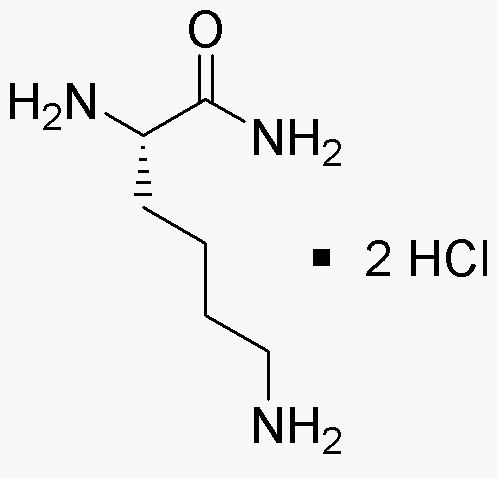L-Lysine amide dihydrochloride is widely utilized in research focused on:
- Nutritional Supplements: It serves as a dietary supplement, particularly for athletes and individuals looking to enhance muscle recovery and growth.
- Pharmaceuticals: This compound is used in the formulation of medications aimed at treating conditions like herpes simplex virus infections, where lysine can help reduce the frequency of outbreaks.
- Animal Feed: It is incorporated into animal feed formulations to promote growth and improve overall health in livestock, ensuring better yield for farmers.
- Cosmetic Products: L-Lysine amide dihydrochloride is used in skincare formulations for its moisturizing properties, helping to improve skin texture and hydration.
- Biochemical Research: Researchers utilize this compound in studies related to amino acid metabolism and protein synthesis, providing insights into cellular functions and nutritional biochemistry.
General Information
Properties
Safety and Regulations
Applications
L-Lysine amide dihydrochloride is widely utilized in research focused on:
- Nutritional Supplements: It serves as a dietary supplement, particularly for athletes and individuals looking to enhance muscle recovery and growth.
- Pharmaceuticals: This compound is used in the formulation of medications aimed at treating conditions like herpes simplex virus infections, where lysine can help reduce the frequency of outbreaks.
- Animal Feed: It is incorporated into animal feed formulations to promote growth and improve overall health in livestock, ensuring better yield for farmers.
- Cosmetic Products: L-Lysine amide dihydrochloride is used in skincare formulations for its moisturizing properties, helping to improve skin texture and hydration.
- Biochemical Research: Researchers utilize this compound in studies related to amino acid metabolism and protein synthesis, providing insights into cellular functions and nutritional biochemistry.
Documents
Safety Data Sheets (SDS)
The SDS provides comprehensive safety information on handling, storage, and disposal of the product.
Product Specification (PS)
The PS provides a comprehensive breakdown of the product’s properties, including chemical composition, physical state, purity, and storage requirements. It also details acceptable quality ranges and the product's intended applications.
Certificates of Analysis (COA)
Search for Certificates of Analysis (COA) by entering the products Lot Number. Lot and Batch Numbers can be found on a product’s label following the words ‘Lot’ or ‘Batch’.
*Catalog Number
*Lot Number
Certificates Of Origin (COO)
This COO confirms the country where the product was manufactured, and also details the materials and components used in it and whether it is derived from natural, synthetic, or other specific sources. This certificate may be required for customs, trade, and regulatory compliance.
*Catalog Number
*Lot Number
Safety Data Sheets (SDS)
The SDS provides comprehensive safety information on handling, storage, and disposal of the product.
DownloadProduct Specification (PS)
The PS provides a comprehensive breakdown of the product’s properties, including chemical composition, physical state, purity, and storage requirements. It also details acceptable quality ranges and the product's intended applications.
DownloadCertificates of Analysis (COA)
Search for Certificates of Analysis (COA) by entering the products Lot Number. Lot and Batch Numbers can be found on a product’s label following the words ‘Lot’ or ‘Batch’.
*Catalog Number
*Lot Number
Certificates Of Origin (COO)
This COO confirms the country where the product was manufactured, and also details the materials and components used in it and whether it is derived from natural, synthetic, or other specific sources. This certificate may be required for customs, trade, and regulatory compliance.


